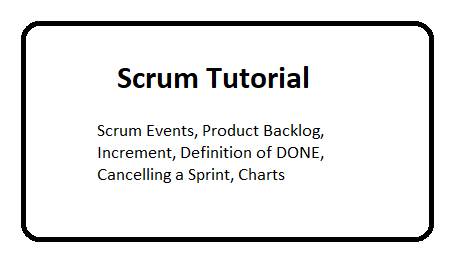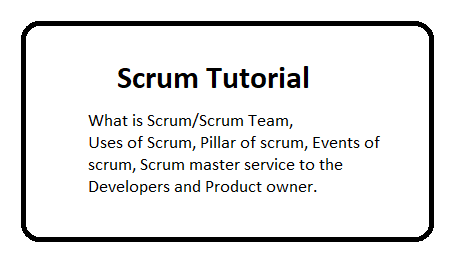
Question: What is Scrum Events?
There are prescribed events that are used in Scrum to create regularity and these are time-boxed events.
Following are 4 Events.
- Sprint planning
- Daily scrum
- Sprint review
- Sprint retrospective
Question: What is Product Backlog?
The Product Backlog is an ordered list of application/software/etc that is known to be needed in the product.
It is the single source of requirements for any changes to be made to the product.
The Product Owner is responsible for the Product Backlog, including its content, availability, and ordering.
Question: What is Sprint Backlog?
The Sprint Backlog is the set of Product Backlog items selected for the Sprint, plus a plan for delivering the product Increment and realizing the Sprint Goal.
The Sprint Backlog is a forecast by the Development Team about what functionality will be in the next Increment
Question: What is Increment?
The Increment is the sum of all the Product Backlog items completed during a Sprint and the value of the increments of all previous Sprints.
Question: What is Definition of DONE?
When a Product Backlog item or an Increment is described as “Done”, everyone must understand what "Done" means.
Before a Product Backlog Item is considered "done" or "complete", it must respect the following criteria (Defination may be similar to below):
--Unit Tests are written and passing
--Acceptance Tests are written and passing
--Accessibility testing using https://wave.webaim.org/
--Continuous Integration (CI) pipeline passing
Question: What is Burn-down Chart?
A chart which shows the amount of work which is thought to remain in a backlog. .
Question: What is Burn-up Chart?
A chart which shows the amount of work which has been completed..
Question: What is Coherent/Coherence?
The quality of the relationship between certain Product Backlog items which may make them worthy of consideration as a whole.
Question: What is Emergence?
The process of the coming into existence or prominence of new facts or new knowledge of a fact, or knowledge of a fact becoming visible unexpectedly.
Question: What is Empiricism?
It has three pillars: transparency, inspection and adaptation.
Question: What is Sprint Retrospective?
Scrum Event that is set to a time-box of 3 hours, or less, to end a Sprint.
Question: What is Technical Debt?
The typically unpredictable overhead of maintaining the product.
Question: What is Artifacts?
An object made by a human being, typically one of cultural or historical interest.
Question: What is Cancelling a Sprint?
A Sprint can be cancelled before the Sprint time-box is over. Only the Product Owner has the authority to cancel the Sprint, although he or she may do so under influence from the stakeholders, the Development Team, or the Scrum Master.
Question: Describe the Scrum Events in Details?
- Sprint planning: A time-boxed event occurs at the beginning of a sprint where the team determines the product backlog items they will work.
- Daily scrum: A is a 15-minute time-boxed event for the Development Team to synchronize activities and create a plan for the next 24 hours.
- Sprint review: A time-boxed event holds at the end of the Sprint to inspect the Increment and adapt the Product Backlog if needed. In this the Scrum Team and stakeholders collaborate about what was done in the Sprint.
- Sprint retrospective: Event for providing an opportunity for the Scrum Team to inspect itself and create a plan for improvements to be enacted during the next Sprint.
